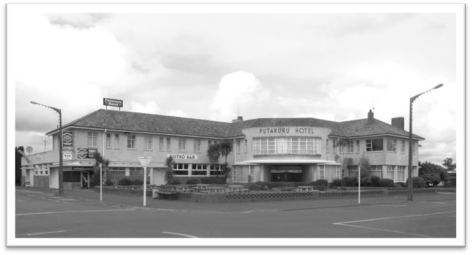HH-38: Putāruru Hotel

Date of Photograph: 04/09/2008
Location and Zoning Information | |
Address |
corner of Arapuni Street and Princes Street. (79 Princes Street). |
Current Owner |
R & LM Norbis Ltd |
Legal Description |
Pt Lot 6 DPS 6183 |
Zoning |
Commercial Zone |
Valuation Number |
0541728800 |
Google Maps Link |
|
Architecture | |
Date of Construction |
|
Materials |
It is composed of modern material, i.e. Reinforced concrete and steel. The interior was not viewed. |
Architecture/Engineer/Builder |
The hotel’s architectural style is inter-war art deco. The massing is asymmetrical. The projecting semi-circular entry emphasises the building’s mass. It features exposed hipped gable roof lines, which are common after 1940. The exterior finishes are smooth, sleek, and have minimal ornamentation. |
Condition |
The building has had a series of additions. Some of the additions match the existing architectural style. The additions are located at the rear and on one side of the building and have only a minor effect on the buildings architectural integrity. |
Original Site Recommendation |
|
Current Use |
The hotel is still in use and is widely advertised on tourist travel sites. |
Statement of Significance |
Criteria for Scheduling: 1, 3, 6, 10, 11, and 12 1. Historical Aspect - associated with Putāruru RR Station (a Junction Station with 2 platforms) provided accommodation for travellers. Replaced the earlier, much smaller Putāruru Junction Hotel. 3. Community association – associated with the growth of Putāruru in the late 1930’s and through 1950’s as a regional centre for the agriculture and timber industry. 6. Educational Use –could be included as an item on a heritage trail, 10. Architectural- Example of inter war Art Deco Style with some international style elements 11. Context cultural landscape/ complex or group – Anchors the southern end of Putāruru. A large hotel complex that expanded rapidly and occupies a large corner section near the RR Station. Demonstrates the commercial vitality the town had in the past. 12. Integrity –good condition/ additions do not compromise the structure District Plan RulesDemolition – DIS. Refer to Rule HH-R3. Protection focus - 1, 3, 6, 10, 11, and 12. Mitigate the effects of demolition by requiring the applicant to provide a Historical Building Documentation (HBD) which should include: the structure’s history, photographic documentation, and measurements of the item prior to removal. Alterations necessary for the primary purpose of improving structural performance, fire safety or physical access – CON -Refer to HH-R2. Other Additions/Alterations - DIS. Refer to Rule HH-R3. Protection focus 10. Effects can be mitigated/ remedied through: a) HBD (see mitigating the effects of demolition). b) Design Rules: The overall visual character/ shape of the original building should be identifiable. The addition should not dominate the existing building frontage on Arapuni Street and Princes Street. The open view of the hotel from the street should be retained. Fences/hedges over 1m in height between the road boundary and the building are discretionary. (The garden / lawn supports the architectural impact of the building). New work should be restricted to the rear of the building and not be evident from the street/ road frontage. Special elements that are associated with the rarity or architectural uniqueness or craftsmanship of the structure should be retained:
c) Building Materials Rule: If repair of the buildings is proposed the materials used for the exterior walls and elements (i.e. Windows, building base, and central entry surround) should be similar in type, dimensions and profile as the existing exterior fabric of the building. Repair of the Structure –PER. Refer to HH-R1. Protection focus – 10. a) Building Materials Rule: If repair of the buildings is proposed the materials used for the exterior walls and elements (i.e. windows, building base, and central entry surround) should be similar in type, dimensions and profile as the existing exterior fabric of the building. b) Design Rule: Repair or replication work should match the existing design, profile, texture (i.e. brick, tile, smooth concrete, metal) of the building elements. Reuse/Change of Use –PER. Refer to HH-R1. Protection focus – 1 and 11. This is generally allowed and supported. Rationale for supporting reuse - history is an ongoing process. Reuse of historic structures in most instances ensures the structure is retained for future generations. Advice or Community concerns will be considered as well as economic viability, Occupational Safety and Health, zoning, etc. Disturbance of the site surface / earthworks – PER Refer to HH-R1. Protection focus - 7. Existing plan rule relating to archaeological sites. This only applies if evidence is found to indicate that there was a pre-1900 site in the development zone. Internal Changes –PER. Refer to HH-R1. Protection focus - 10. Design Rule: Significant interior spaces and use areas should be identifiable. Historic elements should be retained. Remodelling of rooms, hallways, and facilities (kitchens, etc) and the foyer is allowed but alterations must be documented (HBD). Relocation – DIS. Refer to Rule HH-R3. Protection focus - 1, 3, and 11. Relocation may be necessary to preserve an item for future generations. Mitigate the effects by 1) Consulting with the local community and/ or consulting with Iwi or special interest groups, 2) Relocating to a similar setting, 3) Documenting (HBD), 4) Applying the rules relating to archaeological sites. |
History |
Notes: This is not the Putāruru Junction Hotel, which was documented on the heritage inventory form. The existing Putāruru Hotel may have replaced the Putāruru Junction Hotel. The hotel probably filled a need for additional beds near the station when Putāruru station hosted two trains a day. Documenting this building through historical research would be worthwhile and assist in creating a more robust listing. |